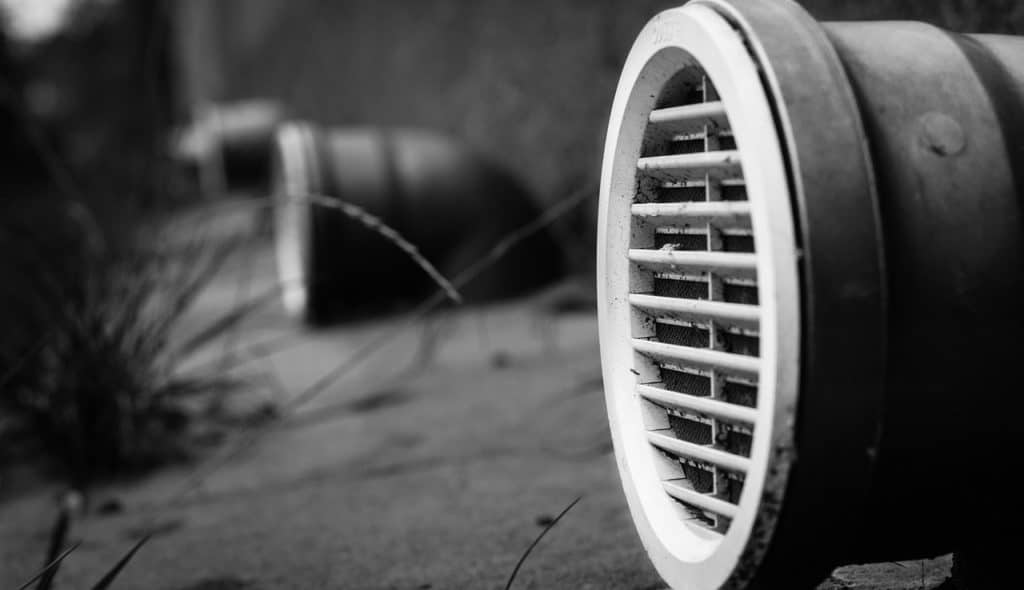
One of the most common mistakes among Canadian growers is forgetting the importance of grow room ventilation. So many growers simply add one or two fans to the setup and assume that’s all they need to do.
Fans are great for circulating air, but they don’t do much in terms of ventilating. For that, you’ll need to invest in some sort of ventilation system kit for air exhaust and intake, like the ones we’ve covered here.
Would you like an ACMPR medical license to grow up to 500 plants at home?
Our #1 Choice
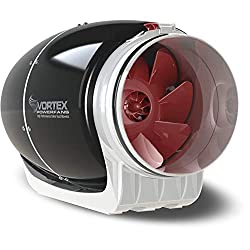
Quietest Fan
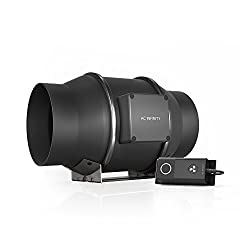
Excellent Fan & Filter Combo
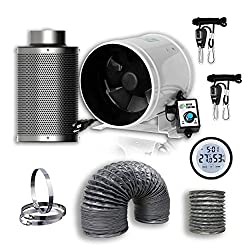
How to Choose a Grow Room Ventilation System
The first step in choosing a grow room ventilation system is to understand what grow room ventilation even is. It’s a system for introducing fresh air into the grow room and expelling stale air out. It also gets the air moving inside the room, keeping it from becoming stagnant.
Most ventilation systems/kits use a combo of exhaust fans and ducts to make these things happen. For circulating the air, an oscillating fan will do the trick.
Now that you have a basic understanding of indoor grow room ventilation, the next step is to decide between a passive vs active intake system. A passive system is a more basic setup that uses a grow room exhaust fan to extract hot air from the room.
There are more moving parts to an active ventilation system, but it’s the better option for larger grow rooms and higher plant counts. In addition to an exhaust fan, an active grow room ventilation kit adds in an intake fan, which works to replenish the room with fresh air.
Things to Consider When Buying a Ventilation System for Your Grow Room
Even after you’ve decided between a passive and active system, the work is not nearly over for selecting a proper grow room ventilation system. Here are a few more things you should consider during the buying process:
CFM Rating
Cubic feet per minute, or CFM, refers to the amount of air that a fan can move per minute. When choosing a fan for a basic ventilation system, it’s always important to consider CFM.
To calculate your grow room’s CFM, multiply its width by length by height. The CFM of the fan that you select should be greater than the cubic feet of your grow room.
Fan/Duct Sizing
Exhaust fans come in a variety of sizes with the most common ones being the 4 inch duct fan, a 6” inline duct fan, and an 8” duct fan. Larger grow rooms require more ventilation, so the 8” duct is the one that pros often turn to. However, the standard size for ducts/fans is 6”.
Exhaust Efficiency
For large grow ops, considering exhaust efficiency is a must. Lots of factors play into exhaust efficiency, like duct length and filter type.
Ducting Material
The most common duct material chosen by Canadian growers is flexible aluminum. It’s easy to work with, lightweight, and budget-friendly. If your budget allows for it, you might think about investing in insulated ducts for better ventilation efficiency.
Budget
Proper grow room ventilation doesn’t need to break the bank, but try not to focus solely on cheap ventilation grow room systems. Spending a bit extra on high-quality materials and durable construction is always worth it, especially for something as important as ventilation.
- Click here to read all about how many plants you can grow or check out our calculator!
- Take a look at our guide to growing cannabis in a greenhouse.
- Follow the links for all you need to know about Rosin Presses and Reverse Osmosis.
Our #1 Choice for Overall Grow Room Exhaust Fan
This grow room exhaust fan will work to maintain humidity levels, add CO2, promote stem growth, and even reduce the risk of pests. All this and more is true of our #1 choice, the Vortex Powerfan S-Line.
Vortex Powerfan S-Line 6”
Our #1 Choice

There are so many reasons we’re loving the Vortex Powerfan, but the main reason is that this is by far the most efficient grow room ventilation system on the market. The S-Line grow room fan is equipped with a backdraft damper, a mixed flow impeller, and speed control settings.
Whether you’re looking for a 10 x 20 grow room ventilation solution or you’re ventilating your trusty 4 x 4 tent, this powerful yet compact exhaust fan is a perfect choice. We love that it can be mounted in any position, and installation is pretty simple with the included mounting bracket.
Carbon Filters to Get Rid of Odor
No ACMPR grower should go without a carbon filter, especially if you prefer potent, skunky strains. Grow room ventilation fans with carbon filters work to remove air contaminants, but mainly, they’re used for getting rid of overwhelming weedy odors.
VIVOSUN 6 Inch Air Carbon Filter Odor Control
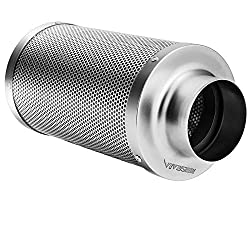
The Vivosun 6” Air Carbon Filter is the ultimate solution for grow room odor control. There are tons of carbon filters to choose from, but the superior carbon quality of the Vivosun delivers 100% filtered airflow. It captures 3x more contaminants than the average carbon filter.
Another thing we love about this filter is that it comes in 3 sizes: 4, 6, and 8-inch. Just choose the size that is compatible with the diameter of your ventilation duct system. This carbon filter is super easy to install, and within minutes you’ll be able to eliminate all pungent smells.
Ventilation System for a Basement Grow Room
Basement grow room ventilation comes with a unique set of challenges. Growing in an entire basement (as opposed to a small tent space) means that you’re handling a major operation, so a small exhaust fan is out of the question.
iPower 6 Inch 350 CFM Inline Carbon Filter
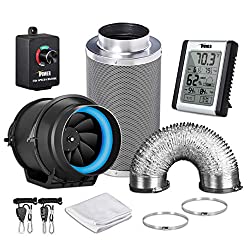
Instead, you’ll need an entire grow room ventilation kit, like the iPower 6″ inline carbon filter and ducting system. The main attraction of this kit is the 6″ inline fan blower with 350 CFM rating. It’s capable of handling a space of 350 cubic feet or less, perfect for a medium-sized basement grow op.
Quiet Exhaust Fans for Your Grow Room
There’s a major difference between a fan that gives off “white noise” and a fan that keeps you up at night. Finding a quiet grow room ventilation system should be one of your main priorities, but unfortunately it’s something that a lot of growers don’t think about until after the fact.
IOBIONICS 6 inch Inline Fan
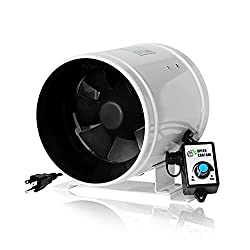
The IOBIONICS exhaust fan grow room model has a noise level that ranges between 35 and 50 decibels. To put things into perspective, the average human whisper has a decibel rating of 20. But quiet operation isn’t the only thing we’re loving about the IOBIONICS fan.
The frame is made from commercial-grade lightweight steel and the fan blade was designed to increase airflow by 50%. It comes in the standard 6” size, but you have the option for a 4” inline fan as well.
AC Infinity CLOUDLINE S6
Quietest Fan

The Cloudline S6 by AC Infinity is not just a quiet ventilation fan for grow room settings. Sure, the 32-decibel noise level makes it one of the quietest intake/exhaust systems on the market, but this all-in-one ventilation system has so much more to offer.
The S6 was designed to quietly ventilate grow tents, transfer heating/cooling to rooms, circulate air, exhaust odors, and cool AV racks. It comes with an 8-speed manual controller, an AC power adapter, and all the necessary mounting hardware for easy installation in any grow room.
Get started on your medical grow license today!
Step 1: Enter your email to book your ACMPR license appointment today
- Compassionate Practitioners Required
- Help with Approvals
- Low Cost Renewals
- No Stress Appointments
Exhaust Fans for Your Grow Tent
These grow tent exhaust fans are specifically designed for ventilation within grow tents. Since grow tents are typically fairly small, grow tent venting systems are often 4” instead of 6 or 8. There’s no need to choose a massive venting system for a small tent.
IOBIONICS Grow Tent Complete Ventilation Kit (2019)
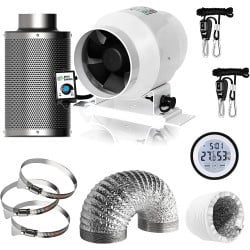
The IOBIONICS exhaust fan for grow tent comes in a complete kit that was updated and improved in 2019. This small grow room ventilation kit comes with everything you could ever need, including an activated carbon filter, a heavy-duty rope ratchet, and a 4” inline fan with speed control settings.
AC Infinity CLOUDLINE T4
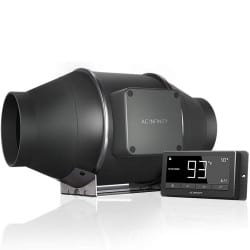
The Cloudline T4 by AC Infinity is a grow room heat and ventilation kit that comes with an attached temperature and humidity controller. This is perfect for grow tent hydroponics since it was designed for gentle ventilation.
It doesn’t just work to circulate fresh air, but also to heat, cool, and exhaust skunky odors. This 4” duct is quiet, and the mixed flow design ranks high in energy efficiency.
Commercial Growroom Ventilation System
Commercial grow room ventilation is a whole new ballgame compared to ventilating small grow rooms and tents. You need something powerful enough to reach all of your plants, and a small 4” duct just won’t cut it.
Atmosphere S-1000 Vortex S-Line Ultra Quiet Fan
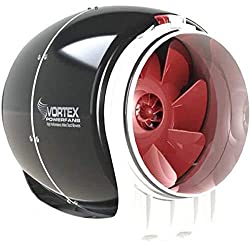
The 10” Atmosphere S-1000 Vortex fan is powerful yet compact, and just like the first Vortex we talked about, this one can be installed anywhere with the included mounting brackets. The high cost is a major bummer, but it’s worth the investment for commercial-level grows.
Excellent Inline Fan and Filter Combo
We’ve covered quite a few inline fan/carbon filter combos, but there’s one that stands above the rest in terms of ventilation performance, efficiency, and price tag.
IOBIONICS Grow Tent Complete Ventilation Kit
Excellent Fan & Filter Combo

This IOBIONICS Grow Tent Ventilation Kit is very similar to the last IOBIONICS kit we covered, but instead of 4” ducts, it comes with 6” components. This is better for medium-sized grow ops, while the other one is more suited to a small tent operation.
When IOBIONICS says “complete”, they mean it. This kit comes with everything you need to set up your ventilation system, including a variable speed controller, flexible aluminum ducting, stainless steel duct clamps, an activated carbon filter, and more.
Why do you need to ventilate your grow room?
One of the main reasons to ventilate your grow room is to enrich your plants with CO2. Without ventilation, they won’t get the CO2 that they are so desperately craving. By regularly flushing the room with fresh air, you’re upping the concentration of CO2 in the process.
But CO2 grow room ventilation is the only reason to invest in ventilation. It also helps with things like heat management, humidity management, and pest control, and on top of all that, proper ventilation promotes stronger plant stems.
How to Ventilate Your Grow Room
There are different ways to ventilate a grow room, so the first step is to choose between exhaust only or a more active air intake system. Unless you just have a few plants, our suggestion is always to an air intake/exhaust combo.
Here are the more specific steps for grow room ventilation:
Place Oscillating Fans in the Room
Proper grow room ventilation requires two types of fans: an air extraction system and oscillating pedestal/wall fans. Oscillating fans are easy to set up, cheap, and they are great for circulating air. Just be sure that the airflow reaches all areas of the grow room.
Setup Your Air Extractor Fan System
An air extractor (AKA an exhaust system) is responsible for extracting old air and introducing fresh air into the grow room. This is a constant process; your air extractor should be working at least every 3-5 minutes, even every minute for larger grow rooms.
Control Humidity & Add CO2
From our guide to the best climate controllers, you already know that humidity plays a major role in your plants’ health – and ventilation plays a major role in humidity control.
It’s easy to ventilate out excess humidity to prevent problems like mold and root rot. To add humidity back into the room, just follow a sealed grow room ventilation design to raise humidity levels. Seal the exhaust fans temporarily until the humidity is back on track.
Injecting CO2 into the room is also possible with the proper grow room ventilation fan. Adding CO2 into the room isn’t for everyone, but the easiest way to inject it into the room is through the ventilation system.
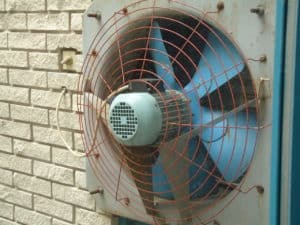
How should a grow ventilation system be set up?
There are 4 general steps to grow room ventilation setup:
Step 1: Attach your grow room inline fan to one of the extra ceiling bars (for grow tents). Adjust the fan positions with rope clip hangers – your fan should hang just a few inches below the ceiling.
Step 2: Secure the inline fan to fit into an exhaust hole, or simply connect your inline fan to additional ducting and run it through the hole.
Step 3: For large grow room ventilation fans with carbon scrubbers, hang your carbon scrubber. This will prevent odors from escaping the grow room – and keep pesky neighbors away.
Step 4: Securely attach the scrubber to the inline fan so that the fan is pulling air through the scrubber. This is easiest when the scrubber and the ducting are the same diameters.
Once the grow room ventilation kit is in place, do a thorough check to make sure everything is working properly. It’s a good idea to keep close tabs on your grow room for the first day or two of using the new ventilation kit/system.
What size fan do I need?
Unfortunately, there’s no grow room ventilation calculator that will tell you the exact fan size to choose. Most growers choose between a 4″ inline fan, a 6″ inline fan, and an 8″ inline fan.
Pro growers with major operations might have a grow room ventilation 12″ fan, and 4” would be fine for grow room closet ventilation. The norm is 6”, but the size of the fan you choose depends on the room’s duct sizes – it’s easiest to buy a fan that’s compatible with the ducts.
Conclusion
It doesn’t matter if you have hundreds of plants or you’re looking for miniature grow room ventilation systems, there’s no denying that grow room ventilation is key.
If you’re still in doubt about which ventilation system to buy, the 6” Vortex Powerfan will steer you (and your grow room’s airflow) in the right direction.
Still have questions about how to properly ventilate your grow room? Feel free to reach out to other ACMPR growers on the CGC Facebook page.

Reader Interactions